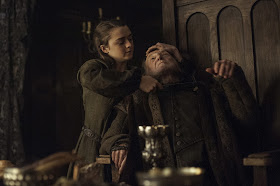A scene from any number of movies or television shows: Character A is approaching Character B. Character A is attempting to express that they mean Character B no harm but we, the audience, can see that Character A is holding a knife out of Character B's line of sight. Character A is saying calming things, making conciliatory gestures with their free hand, signaling with their body language that they aren't a threat to Character B.Character A closes in on Character B and then STAB! Character B never saw it coming.
* * *
5e D&D has rules to adjudicate what happens when you sneak up on a foe and attack them or are in hiding when you attack an enemy ("Unseen Attackers and Targets," PHB 194-195). But how can we model the above scenario in which the target can see their attacker, but don't see the attack coming?
This is my rule: Character A makes either a Charisma (Deception) check (if they are relying on words to disguise the incoming attack) or a Dexterity (Sleight of Hand) check (if they are use agility to misdirect attention from or conceal the weapon they're holding) against a DC set by either Character B's passive Insight or a Wisdom (Insight) check. If character A is successful, their first attack counts as coming from an unseen attacker as per the rules on PHB 194-195; that is, Character A's first attack against Character B is made with advantage. Note that this might allow a rogue to apply sneak attack damage if the attack is successful.

